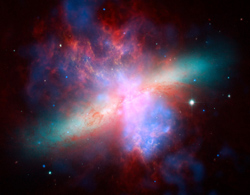 What is the source of cosmic rays?
What is the source of cosmic rays?
Seems like an easy enough question. Cosmic rays are little subatomic particles zipping across the Universe. We’ve known about them for decades, and just about any astronomer who has used a space telescope knows and loathes them; cosmic rays zap our detectors, leaving bright streaks in the images which need to be tediously cleaned out before we can do any real science. I spent a large fraction of my time with Hubble doing just that.
But what’s generating them? They seem to come from all directions in the sky, making it difficult to pin down their source. They’re moving at fantastic speeds, so they must have a huge energy source behind them. For years, astronomers have suspected that they are accelerated to high velocities in supernovae explosions as well as in the fierce solar winds from massive stars. Recent evidence has been making that supposition seem more likely.
And now new results from the VERITAS gamma-ray telescope array have added fuel to that fire. VERITAS stands for Very Energetic Radiation Imaging Telescope Array System, and it’s located atop a mountain in Arizona. When energetic gamma rays (a form of light) hit the Earth’s air, they create a shower of subatomic particle that rains down and can be detected by the telescopes.
If cosmic rays come from supernovae and massive stars, then we should see more of them coming from galaxies that have a lot of stars being born. That’s because massive stars don’t live long. A nearby galaxy vigorously cranking out baby stars will therefore have lots of massive stars making cosmic rays. As a happy by-product, those same massive stars are the ones that blow up as supernovae, giving us a two-fer as far as cosmic ray production goes.
Such a galaxy exists: M82, a weird-looking one located a mere 12 million light years away (it’s close enough to see in binoculars, in fact). The image above is M82 as seen by Hubble, Chandra, and Spitzer. Astronomers trained VERITAS on M82 and took a very, very long exposure. What they found is that is is a weak source of gamma rays, but definitely above the background level. The amount detected is consistent with cosmic rays being generated in the violent environment of the galaxy which then slam into the gas surrounding the stars, generating gamma rays. Another process, called inverse Compton scattering, is probably behind this as well: when a low energy particle of light called a photon hits a cosmic ray, its energy is pumped waaaay up, and it becomes a gamma ray. Think of it like gently throwing a rubber ball in front of a speeding truck on the highway; the ball suddenly and violently finds itself with a lot more energy.
This all may not seem like a big deal, but it is. For one thing, there are a lot of cosmic rays flitting about out there, so knowing what they are and how they formed is clearly a big piece of understanding the high-energy Universe. Also, these cosmic rays may have an effect here on Earth. Scientists have been studying how they may interact with the Earth… and while the effect, if any, is incredibly small (people still argue over whether there is anything to this at all, like cloud formation and such) it’s worth investigating.
And I want to add something that makes me smile. The cosmic rays (which, remember, are subatomic particles) from M82 were detected because while still inside that galaxy they make gamma rays, a form of light, which then travel straight to Earth. But once those gamma rays hit our air they create subatomic particles once again, which are what VERITAS detects. So there are several steps to this process, with cosmic and gamma rays going back and forth until we actually detect their effect. It goes to show that sometimes the key to our understanding the Universe can involve subtle processes piled one atop the other, and it’s up to us to carefully peel back those layers to get to the underlying processes underneath.